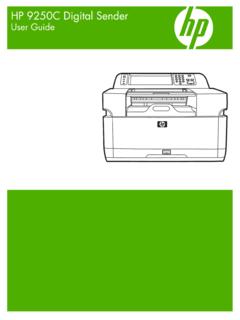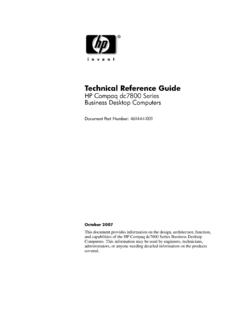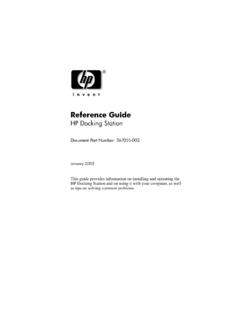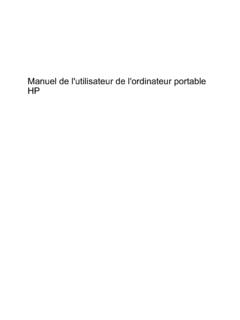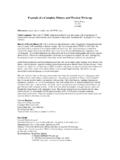Transcription of Smart Array technolog: advantages of battery-backed cache
1 Smart Array technology: advantages of battery -backed cache technology brief 2. 2. Role of cache in the storage 2. Need for a battery -backed cache .. 2. Recovering data from battery -backed 3. Selection criteria for battery -backed 3. Types of batteries .. 4. Importance of a battery maintenance schedule .. 4. battery replacement .. 4. Alternatives to battery replacement .. 4. 5. For more 6. Call to action .. 6. Abstract Many factors affect overall system performance. This paper explains the importance of using battery - backed cache (referred to as the Array Accelerator on HP Smart Array Controllers) to maximize performance of the storage system and to prevent loss or corruption of business-critical data.
2 It also identifies technology introduced in HP Smart Array Controllers that provides exceptional data protection while minimizing the long-term costs of that protection. It is assumed that readers have at least a basic understanding of RAID storage technology Introduction Many factors affect overall system performance. This paper examines the importance of using battery - backed cache on Smart Array controllers to maximize performance of the storage system and to preserve posted-write data in cache . Role of cache in the storage system The process of transferring data to and from disk storage includes storing the data temporarily in cache memory located on the RAID (redundant Array of independent disks) Array controller that is managing the data transfer.
3 cache is comprised of high-speed silicon memory DRAM chips. The access time for writing data to or reading data from DRAM (dynamic random access memory). memory is roughly 106, or a million times faster than the typical access time for writing directly to or reading directly from a set of disk drives. In a posted-write operation, as soon as the host computer writes data to the cache , the write operation is completed; and the host is freed up immediately to perform another operation. The host does not have to wait for the write data to be transferred to disk.
4 Therefore, use of cache memory on HP RAID Array controllers significantly speeds up write operations and increases overall system performance. Posted-write operations also provide other benefits. If the host computer reads from data still residing in write cache , the RAID controller will quickly deliver this read data from its cached contents. If the host writes new data to the same location, the controller will over-write the cached contents, thus eliminating an extra disk write operation. Write cache can improve the performance of any RAID level by combining two or more adjacent write requests into a single request for a disk drive.
5 Such an operation reduces disk rotational latency and processing overhead. Write cache can significantly improve RAID5 performance by accumulating enough write requests to perform a full-stripe write to the disk drives. This eliminates the need to read-modify-write parity data for each write access, since all members of the stripe needed to update the parity are available in the write cache . Need for a battery -backed cache Once a data write is completed, the cache must be able to protect this data in the event of a power loss before the write data is moved to the drives.
6 If external power to the system is interrupted, if the host computer fails, or if the RAID controller fails, battery power maintains data in the cache long enough for the user to recover the data and preserve the integrity of business-critical information. Depending on the capacity of the batteries when external power is lost, battery -backed cache is typically capable of retaining the integrity of data in the cache for several days. The batteries used in HP's battery -backed cache are rechargeable, allowing them to maintain full charge even after a power failure.
7 HP protects cached data by not allowing posted-write operations unless the batteries are at an acceptable charge level to back up data for a predetermined duration. 2. With battery -backed cache available, the RAID controller can also speed up other operations such as capacity expansion and RAID migration by temporarily storing data in battery -backed cache DRAM. instead of on the drives. CAUTION: To avoid risking the integrity of business-critical data, users should always properly shut down the operating system; this guarantees that all posted- write data in the cache will be transferred to the disk drives before power is removed.
8 Recovering data from battery -backed cache If an unexpected power loss occurs while data is held in the posted-write cache , the Smart Array controller will automatically write this data to disk when power is restored within a few days. If power is not restored within a few days, the write- cache batteries will be drained and posted-write data in the cache will be lost. Once system power is restored, the rechargeable batteries will recharge within a few hours. In the event of a server power supply failure, the Smart Array controller card and all of the drives can be moved to another server to allow the data in the write cache to be written to the drives.
9 In the event of a controller failure, the cache module containing posted-write data can be moved to a new Smart Array controller. That new Smart Array controller containing the posted-write data in its cache must be attached to the original drives for which the posted-write data is intended. There is a special concern when using an embedded RAID controller with battery -backed cache . Since the RAID controller is embedded on the server board, if the server board fails, the same model server board must replace it, and the battery -backed cache should be installed on the new server board.
10 Selection criteria for battery -backed cache RAID controller vendors offer products using a variety of battery configurations. Implementations of battery -backed cache vary by type of battery used, usable battery capacity, and the simplicity of data recovery in the event of external power loss. Parameters that affect battery life and performance include: Age of the battery Temperature of the server environment Capacity Memory Effect (which for NiCD batteries dramatically reduces capacity unless periodic full discharges are performed).


